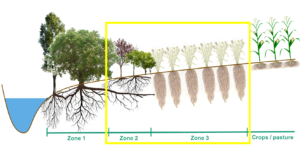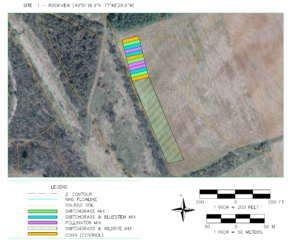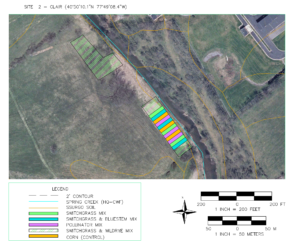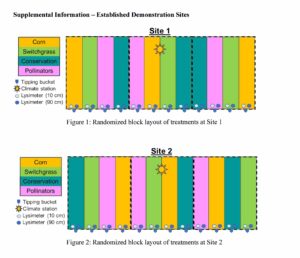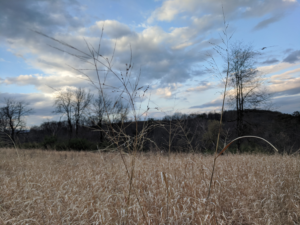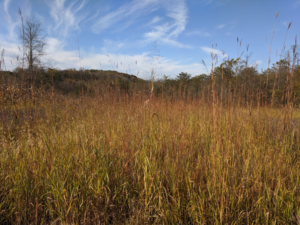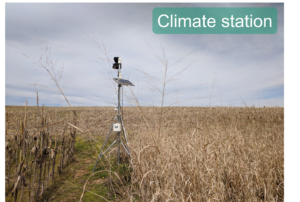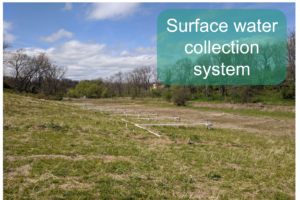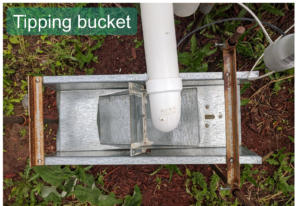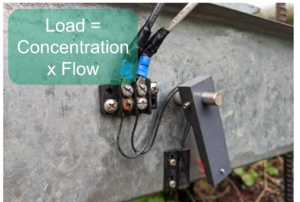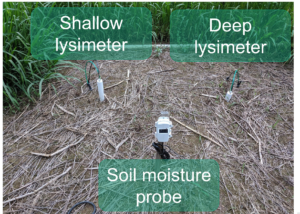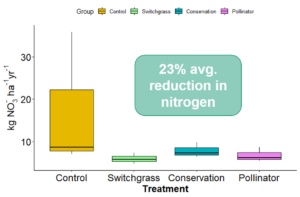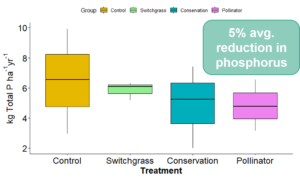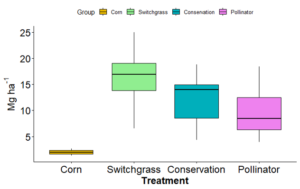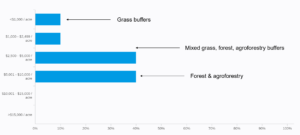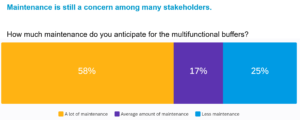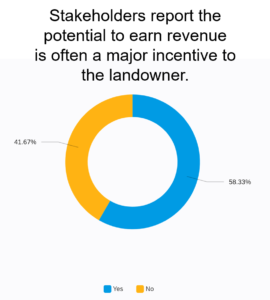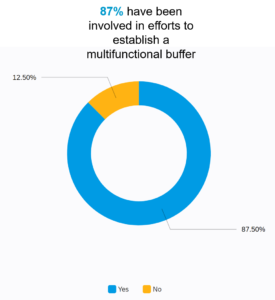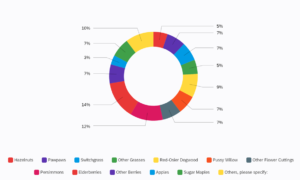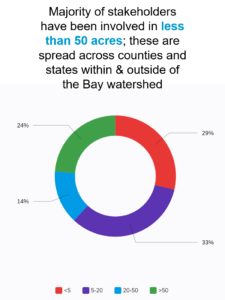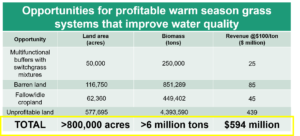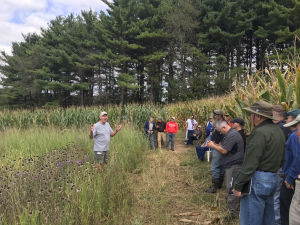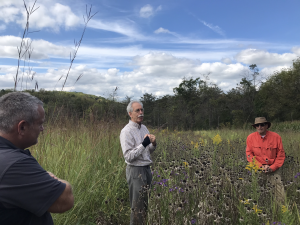Final report for GNE18-173
Project Information
Farmers and other stakeholders across the Commonwealth are working to balance agricultural production with environmental goals (water quality, soil health, carbon sequestration), and implement more resilient farming systems in the face of extreme weather events. One of Pennsylvania's core strategies to achieve this balance is through the implementation of over 100,000 acres of forest and grass riparian buffers by 2025. Unlike traditional buffers that do not generate profit, "multifunctional buffers" are strips of perennial vegetation (native grasses and other agroforestry products) between streams and crop fields that can improve water quality and generate revenue in addition to providing other ecosystem services. Multifunctional buffers can help farmers balance production with environmental quality and better manage the risks of floods and drought. However, there is a need to demonstrate perennial buffer crops that work in terms of profit-potential and water quality impact in Pennsylvania for farmers and other stakeholders, and to quantify their impact.
This project aimed to fill these gaps by 1) establishing two multifunctional buffer sites and monitoring those sites for water quality impacts and yield, 2) engaging farmers at the sites so the practice can move beyond the demonstration sites to other farms in the state, 3) thinking beyond buffer areas to identify other opportunity areas across the Commonwealth where conversion to perennial systems like multifunctional buffers may make economic and environmental sense. The multifunctional buffer sites were established in the Spring Creek watershed in Centre County. One was established along an identified priority buffer area (a riparian buffer), and one was established outside of the riparian zone on what the farmer described as marginal or unprofitable land (a field buffer).
We found planting buffers of warm-season grasses along marginal agricultural fields and in riparian buffers along streams can reduce nitrate-nitrogen and phosphorus loads to surface waters and produce biomass that can generate revenue for farms that is competitive with corn production. Using data, lessons learned and by leveraging field demonstrations established during this project to engage farmers, we are now piloting the concept of buffers with trees and warm-season grasses through a collaboration with Clearwater Conservancy and a Department of Conservation and Natural Resources (DCNR) grant on 33-acres in the Halfmoon Creek watershed. The 33-acres will be planted on 4 farms that had not previously considered the practice starting in Fall 2020 into Spring 2021. Finally, through analysis of Landsat-8 and Sentinel-2 satellite imagery (used to calculate the normalized difference vegetation index and estimate yield) and agronomic crop budgets, we identified unprofitable annual cropland suitable for warm-season grasses and profitable annual cropland to add other double crops (winter rye) in Pennsylvania. We estimate the potential impact of the identified opportunity land areas is 995,000 hectares which could produce >7 million Mg of biomass and generate $594 million in revenue for farmers in the Commonwealth.
Challenges
We experienced challenges in establishing warm-season grasses at our riparian buffers demonstration site, including establishment during an extremely wet year (2018), seed loss, invasive weeds, and cool-season grass competition. We learned site preparation is key in warm-season grass establishment and as a result, have planned more intensive site preparation methods over multiple seasons and dormant season plantings (which is often a drier time than spring planting for the 33-acres that are being planted in 2020-2021 with Clearwater Conservancy, a funding opportunity that was built upon because of this grant.
The specific objectives of this study were to:
- Develop a strategic plan for planting perennial crops in riparian buffers on unprofitable cropland for farms in Pennsylvania.
- Determine the water quality benefits of converting conventional annual cropland to multifunctional buffers planted with native perennial grass mixtures.
- Evaluate the potential yield and economic benefit of planting multifunctional buffers with native grass mixtures.
- Disseminate findings outside academia. The results have been and will be disseminated not only through academic journals, but through extension publications, workshops, field days, and other mechanisms that reach farmers and other stakeholders within and outside of the Chesapeake Bay.
The purpose of this project was to accelerate buffer plantings across the Chesapeake Bay watershed and beyond by demonstrating, documenting, and disseminating perennial agricultural practices that can achieve environmental goals in synergy with farm profitability. The Chesapeake Bay has been listed on the United States Department of Environmental Protection (USEPA) Section 303(d) list of impaired waters since 1998 (USEPA 2017a). To remove the Bay’s impaired listing, federal (USEPA) and state governments (New York, Pennsylvania, Maryland, Delaware, Virginia, West Virginia, and Washington D.C.) enacted the Chesapeake Bay Clean Water Blueprint in 2010 establishing Total Maximum Daily Loads (TMDL) or pollutant limits for Bay states, and Watershed Implementation Plans (WIP) for reducing pollutants including nitrogen, phosphorus, and suspended sediment. As part of the plan, the Chesapeake Bay aimed to plant 900 miles of buffers annually but Bay states like Pennsylvania have consistently missed this goal. In fact, Pennsylvania has only established less than 20% of its 100,000+ acre goal with only 18,602 acres of new buffers planted since 2010 (Devereux 2018). Yet establishing buffer acres in Pennsylvania is imperative as the state supplies more than 35% of the freshwater to the Bay via the Susquehanna River and contains 19,000 miles of impaired streams (PADEP, 2016). Current estimates are that Pennsylvania's intensive agricultural systems are responsible for more than 30% of the nitrogen, phosphorus, and sediment pollution loading to the Bay, primarily by fertilizers on annual crops. The state is unlikely to get back on-track without heavy incentives for farmer buy-in like government subsidies well beyond what the state legislature and taxpayers have been willing to do, or new market opportunities that provide for long-term buffer profitability. State funding for subsidizing buffers has been cut annually, and new profit-generating buffer concepts like the Department of Conservation and Natural Resources’ (DCNR) multifunctional buffer concept (DCNR, 2015) are still limited in scope and fail to link farmers to existing and growing markets. This predicament comes at a time when the northeast agricultural community is in need of the kind of economic diversification and resilience that multifunctional buffers may be able to provide. Research suggests diversifying agriculture and encouraging multifunctional agriculture could provide synergistic environmental, economic, and social benefits (Boody et al., 2005; Brown, Goetz and Fleming, 2012). Research also suggests harvesting the vegetation in buffers does not negatively impact the function of the buffer in improving water quality (Jiang et al., 2020). In fact, Jiang et al., 2020 reported grass vegetation (like a switchgrass buffer), which farmers often prefer over trees, outperformed woody vegetation for sediment, nitrogen, and phosphorus removal. The practical approach we are piloting to accelerate planting of buffers includes targeting unprofitable cropland for planting multifunctional buffers with native grasses, and financing these buffers primarily through the sale of the warm-season grasses with minimal government subsidies.
Figure 1: Schematic of a typical multifunctional buffer that includes a strip of perennial woody vegetation (trees) immediately along the edge of the stream followed by zones of harvestable buffer crops. In this case, we are proposing warm-season grasses in zones 2 and 3, and for streams where a grass buffer is appropriate, zone 1. Buffers can also be along the edge of farm fields without streams.
Cooperators
Research
Two 1-acre demonstration sites were established on two farms in Central Pennsylvania in July 2018 in partnership with Ernst Conservation Seeds; one on Penn State land (see Figure 2 for site map), and one on a collaborating farm with private landowners (2 farmers) who directly participated in the research (see Figure 3 for site map). These sites were planted in a randomized block design (see Figure 4 for site layout) with 3 blocks and 4 treatments per block, a control (business-as-usual corn), a switchgrass mix with three cultivars (Table 1), a mix with switchgrass and Big Bluestem (Table 2) selected for strong biomass production, and mix with switchgrass and six herbaceous pollinator-attractors (Table 3). See Figures 5 and 6 for photos of established grasses.
Figure 2: Site map Rockview site
Figure 3: Site map collaborating farm
Figure 4: Randomized block design at each site
Table 1: Treatment 1 seed mix
Table 2: Treatment 2 seed mix
Table 3: Treatment 3 seed mix
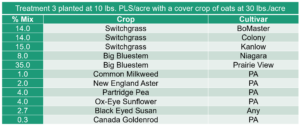
Figure 5: Switchgrass at the 1
Figure 6: Big Bluestem at site 1
Both demonstration sites are equipped with a climate station (Figure 7) to monitor precipitation, a surface water collection system to collect surface water samples (Figure 8), tipping buckets to monitor flow (Figure 9), and lysimeters to collect subsurface water samples (Figure 10). Starting in January 2019, samples were collected and analyzed for nitrate-nitrogen, total and orthophosphate, and sediment load reductions across the plots. Yield data were collected for the corn and grass plots in 2019 and 2020.
Figure 7: Climate station
Figure 8: Surface water collection system
Figure 9: Tipping buckets with reed switches to record flow
Figure 10: Lysimeters
In addition to research efforts at the demonstration sites, field days and tours at the demonstration sites were held in 2019 and 2020 to engage farmers, extension agents, academics, government, students, and conservation groups. A workshop was also held with supplemental funding obtained from the Chesapeake Bay Program Scientific and Technical Advisory Committee on November 14-15, 2018 to discuss perennial grasses and understand how they might help accelerate riparian buffers plantings in the Bay. The workshop (workshop breakout session shown in Figure 11) included approximately 50 participants including farmers and stakeholders from academia, industry, and government. A webinar was held before the workshop to share stakeholders' (including farmers) experiences regarding perennial grasses and buffers (Figure 12). A post-workshop survey was conducted in 2020 to assess whether farmers and stakeholders that attended field days and workshops during this project altered their practices including if they planted new acres of perennials.
Figure 11: Stakeholders in a small breakout session at the workshop
Figure 12: Pre-workshop webinar is available on YouTube here and the post-workshop report is available online here.
Results (Figures 13-15) indicate an improvement in water quality when buffers and the edges of marginal fields are planted with perennial grasses compared to cropped conventionally with an annual crop like corn. The results of this project will be further disseminated in a journal publication in 2021.
Figure 13: The average nitrate-nitrogen reduction in the warm-season grass plots was 23% compared to the corn. Switchgrass performed the best of the mixes.
Figure 14: The average total phosphorus reduction in the warm-season grass plots was 5% compared to the corn. Switchgrass performed the best of the mixes.
Figure 15: Corn yields at both sites were consistently low -compared to the warm-season grasses due to flooding, and wild animal pressure.
A post-workshop survey revealed stakeholders are still in the beginning stages of accelerating multifunctional buffers across the Commonwealth and the Bay, and they are still reporting high costs of buffer implementation and maintenance; maintenance is still a concern of the majority of stakeholders. Figures 16-21 share some of the post-workshop survey results.
Figure 16: Post-workshop survey revealed the monetary needs for implementing forest buffers are (not surprisingly) higher than grass buffers and that a mix of grass and forests falls in the middle.
Figure 17: Post-workshop survey reveals stakeholders are still concerned with the maintenance of buffers.
Figure 18: Post-workshop survey reveals revenue is a major incentive to landowners considering buffers.
Figure 19: Post-workshop survey reveals the majority of stakeholders have been implementing multifunctional buffers since the 2018 workshop.
Figure 20: Post-workshop survey reveals no clear "best" multifunctional buffer crop at this time, and rather stakeholders are focusing on several crop options including switchgrass, fruits, nuts, berries, and sugar maple.
Figure 21: Post-workshop survey reveals most stakeholders are planting small buffer sites and no major stakeholders have begun to accelerate multifunctional buffer plantings at the scale needed to meet Bay goals.
There is a potentially large opportunity to improve water quality and profits with warm-season grasses in Pennsylvania by implementing warm-season grass buffers along streams and on other opportunity areas like on barren land, fallow and idle cropland, and unprofitable land. However, there is also still a lot of work to be done in implementing these solutions on the ground.
Through analysis of Landsat-8 and Sentinel-2 satellite imagery, used to calculate the normalized difference vegetation index and estimate yield, and agronomic crop budgets, we identified unprofitable annual cropland suitable for perennial bioenergy feedstocks and profitable annual cropland to add bioenergy double crops (winter rye) in Pennsylvania. Also through analysis of the United States Department of Agriculture's Cropscape Database, we quantified other opportunity areas available for warm-season grass production that could improve water quality and provide revenue to rural economies. Table 4 summarizes our opportunity land analysis. We used county-level switchgrass yields from Field et al., 2020 to estimate the biomass opportunity at the county level in Pennsylvania for the opportunity areas that are not riparian buffers. We estimate there may be over 800,000 acres in Pennsylvania where farmers could generate more than 6 million tons of warm-season grasses like switchgrass and generate almost $600 million in revenue.
Table 4: Opportunities in PA for warm-season grasses
The Chesapeake Bay Program Scientific and Technical Advisory Committee multifunctional buffer workshop (a grant obtained to build on this project's effort) post-workshop survey reveals there is still more work to be completed. Figure 22 includes what stakeholders reported is still needed to accelerate buffer plantings including more technical assistance, a robust and comprehensive supply chain, using a systems approach (buffers are one part of the system), and tying the multifunctional buffer to the farm as a whole.
Figure 22: Stakeholder responses in a post-workshop survey in response to being asked "What is needed to accelerate buffer plantings?"
Education & Outreach Activities and Participation Summary
Participation Summary:
Workshops
- Chesapeake Bay Program Scientific and Technical Advisory Committee Multifunctional Buffer Workshop (November 2018); 2 farmers participated
Field days
- Penn State Warm Season Grasses Field Day and Tour (September 2019); 12 farmers participated; https://extension.psu.edu/warm-season-grasses-field-day-and-tour
- Halfmoon Township buffer tour with Clearwater Conservancy (July 2019)
- Ag Progress Days buffer tour (August 2019)
Tours
- Penn State Rockview Farm Native Grasses for Water Quality Tour - PSU Nutrient Management in Agricultural Systems course (Fall 2019)
- Penn State Rockview Farm Native Grasses for Water Quality Tour - PSU Nutrient Management in Agricultural Systems course (Fall 2020)
Webinar
- Chesapeake Bay Program Scientific and Technical Advisory Committee pre-workshop webinar (October 2018); https://www.youtube.com/watch?v=QqBH1dSuZBg&feature=youtu.be
- Assocciation of Warm Season Grass Producers Annual Meeting, Webinar week 2 (July 2020); https://www.youtube.com/watch?v=kCfRjEyCMHk&feature=youtu.be
Presentations
- Steph Herbstritt, Tom Richard. Grass to Gas: Opportunities for biogas from buffers to unprofitable land to your backyard and more! CCHANGE Why are we missing the boat on biogas? Conference. October 19, 2020.
- Steph Herbstritt, Tom Richard. Sustainable Feedstock Production: Reenvisioning Buffers & Other Opportunity Areas to Improve Water Quality, Farm Profits and Manage Risk. AICHE Bioenergy Sustainability Conference. Poster presentation. October 2020.
- Steph Herbstritt & Lara Fowler. Report on Multi-Functional Buffer Workshop (2018). Establishment of multifunctional riparian buffers: How do we accelerate the path to 95,000+ acres with the greatest economic, social, and environmental impact? Chesapeake Bay Program Water Quality Goal Implementation Team Meeting. August 24, 2020.
- Lara Fowler, Steph Herbstritt & Veronika Vazhnik. Report on Multi-Functional Buffer Workshop (2018). Chesapeake Bay Program Ag Workgroup. April 16, 2020.
- Steph Herbstritt, Tom Richard. Native Perennial Grasses in Multifunctional Riparian Buffers for Water Quality and Farm Profit. Oral presentation. International Association for Landscape Ecology Annual Meeting. March 2019.
- Steph Herbstritt, Tom Richard. Accelerating the path to 95,000 acres in the Bay. Riparian Forest Buffer Summit. Oral presentation. February 2019.
- Steph Herbstritt, Tom Richard. Planting native perennial grasses in multifunctional riparian buffers for water quality and farm profitability. Oral presentation. Ernst Eastern Native Grass Symposium. September 2018.
Fact sheets
In draft: Herbstritt, Richard, Brandau. A new economic opportunity for PA.
Publications
- Herbstritt, S., V. Vazhnik, L. Fowler, T.L. Richard, A. Harvey, D. Nardone, P. Kleinman, S. Fanok, C. Ernst, J. Duncan, C. Hinrichs, F. Circle, S. Nicholas, T. Coulter, and, T Stark. 2019 Establishment of Multifunctional Riparian Buffers. STAC Publication Number 19-008, Edgewater, MD. 48 pp. https://www.chesapeake.org/stac/wp-content/uploads/2019/12/FINAL_STAC-Report_Multifunctional-Buffers_12.20.2019.pdf
Demonstration sites
- Penn State Rockview Farm in State College, PA
- Collaborating Farmer in State College, PA
Additional sites (with trees and grass) planned for 2020-2021 with Clearwater Conservancy
- Three farms in the Halfmoon Township Watershed in Centre County, PA
- One farm along Slab Cabin Run in Centre County, PA
Photos from stakeholder engagement days
Figure 23: Will Brandau speaking at Field Day at demonstration site 1
Figure 24: Project PI (center) at field day with collaborator, Calvin Ernst (right), and a farmer (left) at Field Day in 2019
Project Outcomes
Based on the results of the field study, there is a potential to reduce nitrate-nitrogen and phosphorus when converting portions of edges of fields or riparian buffers to warm-season grass mixtures. There is also the potential to produce biomass in multifunctional buffers and on opportunity land to generate revenue for farmers in Pennsylvania with fewer inputs and a lower environmental footprint than corn production.
Grants received that built upon this project
- Steph Herbstritt, The Energy and Environmental Sustainability Laboratories (EESL) Green Seed Student Grant. $1,840.52. Funding period: 2/13/2019 – 6/31/2019.
- Lara Fowler, Tom Richard, Steph Herbstritt, Veronika Vazhnik. Establishment of multifunctional riparian buffers: How do we accelerate the path to 95,000+ acres with the greatest economic, social and environmental impact, Chesapeake Bay Program Scientific and Technical Advisory Committee (CBP STAC), $10,000. Funding period: 6/1/2018 – 2/13/2019.
- ClearWater Conservancy (Deb Nardone, Suzy Yetter, Colleen DeLong), Steph Herbstritt, Tom Richard. Using perennial biomass crops in multifunctional riparian forest buffers for improving water quality and farm profitability, Pennvest/DCNR, Grant No. BRC-RFB-24-184, $88,000. Grant period: 1/1/2019 – 12/31/2022.
New working collaborations
- Clearwater Conservancy and Penn State are now working to plant 33 acres of multifunctional buffers with native perennial grasses in Central Pennsylvania. Four farms decided to change their practices and plant a multifunctional buffer which will be planted in 2020-2021.
This project was successful in creating new collaborations, establishing a good demonstration site, and disseminating information outside of academia. The key to that success was kicking off the project by obtaining additional funding from the Chesapeake Bay Program Scientific and Technical Advisory Committee (CBP STAC) to engage with stakeholders and understand what is needed to accelerate buffers across the Commonwealth of Pennsylvania and obtaining additional funding from the Department of Conservation and Natural Resources to actually plant 33-acres of multifunctional buffers in Pennsylvania through a newly formed collaboration with Clearwater Conservancy. More work is needed to build comprehensive supply chains for multifunctional buffer products and grow markets for buffer crops. Markets could include bioenergy and renewable natural gas produced from perennial biomass grown in buffers, erosion control socks, mushroom substrate, floral arrangements, and edible products. Work is also needed to reduce maintenance requirements in buffers and find ways to implement low-maintenance buffers or create buffer maintenance programs that reduce maintenance requirements and costs for individual farmers. More work is also needed to incorporate buffers into the farm system as a whole and look at a systems approach to improving water quality on individual farms rather than solely focusing on buffers.
